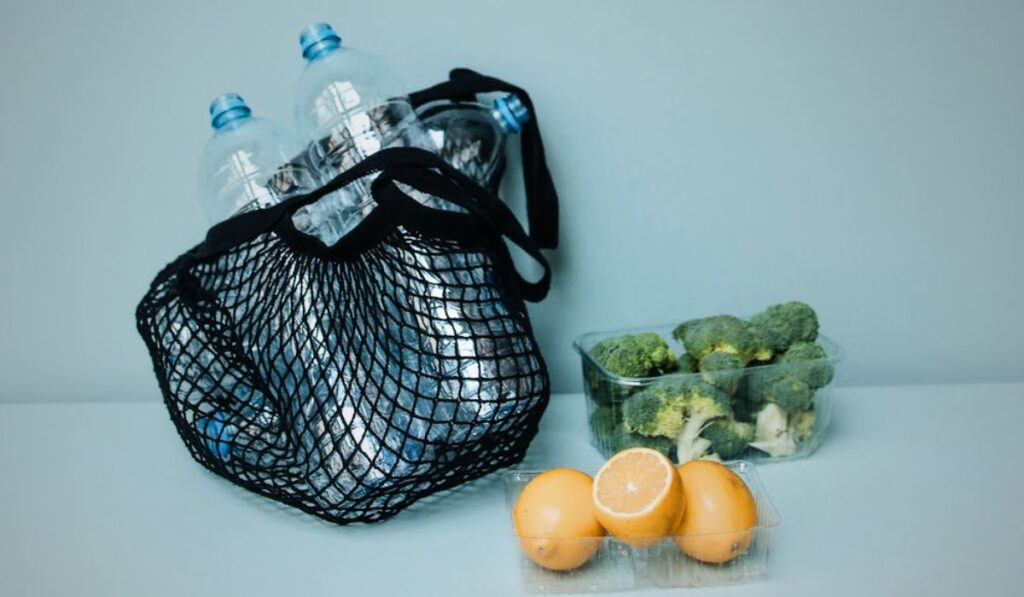Microplastics can be formed when larger plastic pieces break down after being exposed to the elements for an extended period of time. Approximately 36% of the 400 million tonnes of plastic waste we produce each year is utilized in packaging. When plastic was first developed, it was believed to be a remarkably durable material. Before recent investigations revealed that it was actually harming the environment, it was a groundbreaking substance.

Plastic is non-biodegradable, thus it does not decompose quickly; instead, over a longer period of time, it fragments into tiny pieces, which are referred to as microplastic. These secondary microplastics can end up in the soil and water, which can then be absorbed by plants. Microplastics are small plastic particles that are less than 5mm in size. Due to their small size, microplastics are easily ingested in food, water, and the environment.
Several studies have found microplastics in fruits and vegetables. Plastic packaging used to store and transport fruits and vegetables can also be a source of microplastics. Plants can absorb microplastics through their root systems, which can then accumulate in the edible parts of the plant. This means that microplastics can enter the food chain through the soil.
POST CONTENTS
Microplastic Contamination in Fruits & Vegetables
According to a study by University of Catania scientist Margherita Ferrante, the fruit had a higher level of microplastics than vegetables, possibly because fruit trees are older and have been exposed to more environmental pollution. Another study found that microplastics less than 10 μm ranged from 52,050 to 233,000 particles/g depending on the vegetable samples. The largest microplastics found through the study were in lettuce. Microplastics have been found in other foods such as beer, wine, rice, table salt, and honey. Here are the fruits and vegetables that are most likely to contain microplastics:
- Apples: Apples are the most contaminated fruit, with an average of 195,500 plastic particles per gram.
- Carrots: Carrots are the most affected vegetable, averaging more than 100,000 plastic particles per gram.
- Lettuce: Lettuce has been found to have an average of more than 100,000 plastic particles per gram.
- Broccoli: Broccoli has been shown to be one of the most contaminated vegetables, averaging more than 100,000 plastic particles per gram.
How Does Microplastic End Up in Fruits and Vegetables?

Microplastics can end up in fruits and vegetables in various ways. Here are some of the ways microplastics can end up in fruits and vegetables:
Plants can absorb microplastics through their root systems, which can then accumulate in the edible parts of the plant. This means that microplastics can enter the food chain through the soil.
Microplastics can be formed when larger plastic pieces break down after being exposed to the elements for an extended period of time. These secondary microplastics can end up in the soil and water, which can then be absorbed by plants.
Microplastics can be found in irrigation water, which can then be absorbed by plants.
Plastic packaging used to store and transport fruits and vegetables can also be a source of microplastics.
According to a study by University of Catania scientist Margherita Ferrante, the fruit had a higher level of microplastics than vegetables, possibly because fruit trees are older and have been exposed to more environmental pollution. Another study found that apples are the most contaminated fruit, while carrots are the most affected vegetable. The level of microplastics in fruits and vegetables can vary depending on the type of produce and where it was grown.
In conclusion, microplastics can end up in fruits and vegetables in various ways, including absorption through the root system, secondary microplastics, irrigation water, and plastic packaging. It is important to take steps to reduce exposure to microplastics in food, such as choosing fresh, whole foods instead of processed foods, washing fruits and vegetables thoroughly before eating them, avoiding plastic containers or utensils when storing or cooking food, and supporting efforts to reduce plastic pollution and promote sustainable practices.
Health Risks of Microplastics
Microplastics have been identified as toxicological vectors, meaning they can adsorb additional chemicals on their surfaces before coming in contact with a human cell, which can increase their toxicity. However, the long-term health effects of consuming microplastics are not yet fully understood. More research is needed to determine the potential risks of microplastics in food.
Here Are Some of the Health Risks That Have Been Associated With Consuming Microplastics
- Exposure to microplastics is also suspected to be a reproductive hazard to humans.
- Microplastics can reduce the diversity of the gut microbiome, which can lead to negative health effects.
- Hormone imbalance in the digestive system can result from exposure to microplastics.
- Microplastics can absorb toxic substances, which can increase the risk of infection in the digestive system.
- When inhaled, microplastics may trigger oxidative stress in the airways and lungs, resulting in respiratory symptoms.
- Microplastics have been shown to have neurotoxic & carcinogenic effects.
- Microplastics, which can cause infections and digestive problems because they absorb hazardous compounds, have been discovered in small tests to be present in the human stomach and bloodstream.
- Exposure to microplastics is suspected to be a digestive hazard to humans, including cancer.
It is important to note that the long-term health effects of consuming microplastics are not yet fully understood, and more research is needed to determine the potential risks of microplastics in food. However, given the potential health risks associated with consuming microplastics, it is important to take steps to reduce exposure, such as choosing fresh, whole foods instead of processed foods, washing fruits and vegetables thoroughly before eating them, avoiding plastic containers or utensils when storing or cooking food, and supporting efforts to reduce plastic pollution and promote sustainable practices
Ways to Prevent Exposure to Microplastic in Foods
Eat more fresh food and fewer processed foods :
Compared to severely processed foods, fresh foods including fruits, vegetables, and whole grains are less likely to be contaminated with microplastics.
Instead of bottled water, use filtered tap water
Filtered tap water is a healthier choice that helps reduce our intake of microplastics. Bottled water has been found to have double the amount of microplastics compared to filtered tap water.
Make use of environmentally friendly bottles, including glass or stainless steel ones
Microplastics can leak into the liquids they hold from plastic bottles, particularly those made of low-quality plastics. Because glass and stainless steel bottles are non-reactive, no chemicals will leak into your drinks, minimizing any potential health hazards.
Make use of sustainable packaging
Using sustainable packaging is important for reducing microplastic contamination. Plastic packaging can release tiny plastic particles into the environment. Sustainable packaging options, like biodegradable or compostable materials, help reduce plastic waste and prevent microplastic pollution.
Plastic containers should not be microwaved
To avoid microplastics, never microwave plastic containers. Heating them can cause tiny plastic particles to enter your food. Instead, use microwave-safe glass or ceramic containers. These won’t release harmful particles, ensuring safer and healthier meals.
Replace disposable cups with reusable, environmentally friendly ones
Replace disposable cups with reusable, eco-friendly ones to reduce exposure to microplastic. Drinks may include microplastics from disposable cups. Using reusable cups allows you to drink without being concerned about potentially hazardous contaminants, reduces waste, and is better for the environment.
Eco-friendly kitchen tools
Opt for kitchen utensils and tools made from non-plastic materials, such as wooden spoons, stainless steel strainers, or glass mixing bowls, to avoid potential microplastic contamination during food preparation.
Consume less seafood
Some seafood, unfortunately, contains microplastics since the marine environment is contaminated with them. It is important to pay attention to small fish that are consumed whole and bivalves, such as clams, oysters, muscles, and scallops. Reduce your consumption of these types of seafood to reduce your exposure.
Plastic-free storage
Store leftovers or meal preps in glass containers with silicone or cloth lids instead of plastic containers. This helps prevent microplastic transfer from plastic storage containers.
Regularly clean your home to prevent dust buildup of microplastics.
It’s crucial to remember that lowering exposure to microplastics overall includes a variety of measures, not only reducing exposure to microplastics in food. Reduced plastic manufacturing and consumption, wearing eco-friendly clothes made of natural materials, and support for initiatives to reduce plastic pollution and advance sustainable lifestyles are all further actions that can be performed.
The Bottom Line
In conclusion, microplastics are present in fruits and vegetables and are a growing concern due to their potential health risks. While more research is needed to fully understand the long-term effects of consuming microplastics, it is important to take steps to reduce exposure. Consumers can make choices that support sustainable practices and reduce plastic pollution.
References :
- Batista, C. (2023, January 11). Do You Know How To Avoid Microplastics In Food? – The Eco Hub. The Eco Hub. https://theecohub.com/how-to-avoid-microplastics-in-food/
- Bhuyan, M. S. (2022). Effects of microplastics on fish and in human health. Frontiers in Environmental Science, 10. https://doi.org/10.3389/fenvs.2022.827289
- Campanale, C., Massarelli, C., Savino, I., Locaputo, V., & Uricchio, V. F. (2020). A detailed review study on potential effects of microplastics and additives of Concern on human health. International Journal of Environmental Research and Public Health, 17(4), 1212. https://doi.org/10.3390/ijerph17041212
- Conti, G. O., Ferrante, M., Banni, M., Favara, C., Nicolosi, I., Cristaldi, A., & Zuccarello, P. (2020). Micro- and nano-plastics in edible fruit and vegetables. The first diet risks assessment for the general population. Environmental Research, 187, 109677. https://doi.org/10.1016/j.envres.2020.109677
- Greenpeace East Asia. (2020, July 21). 3 Everyday Foods that Contain Microplastics – Greenpeace East Asia. https://www.greenpeace.org/eastasia/blog/6016/3-everyday-foods-that-contain-microplastics/
- Kwon, J. H., Kim, J., Pham, T. S., Tarafdar, A., Hong, S., Chun, H. J., Lee, S. Y., Kang, D., Kim, J. H., Kim, S. B., & Jung, J. (2020). Microplastics in Food: A review on analytical methods and challenges. International Journal of Environmental Research and Public Health, 17(18), 6710. https://doi.org/10.3390/ijerph17186710
- Lee, Y., Cho, J., Sohn, J., & Kim, C. (2023). Health effects of microplastic exposures: current issues and perspectives in South Korea. Yonsei Medical Journal, 64(5), 301. https://doi.org/10.3349/ymj.2023.0048
- Lim, X. (2021). Microplastics are everywhere — but are they harmful? Nature, 593(7857), 22–25. https://doi.org/10.1038/d41586-021-01143-3
- Lozanova, S. (2022). How To Reduce Your Exposure to Microplastics. Earth911. https://earth911.com/health/reduce-microplastic-exposure/
- Regnier, E. (2020, June 26). New Studies: Microplastics found in fruit and veg – Plastic Soup Foundation. Plastic Soup Foundation. https://www.plasticsoupfoundation.org/en/2020/06/new-studies-microplastics-found-in-fruit-and-veg/
- Scientists discover microplastics inside fruit and vegetables – Greenpeace USA. (2020, June 26). Greenpeace USA. https://www.greenpeace.org/usa/news/scientists-discover-microplastics-inside-fruit-and-vegetables/
- Silva, G., Madrid, F. M. G., Hernández, D., Pincheira, G., Peralta, A. K., Gavilán, M. U., Vergara-Carmona, V., & Fuentes-Peñailillo, F. (2021). Microplastics and their effect in horticultural crops: food safety and plant stress. Agronomy, 11(8), 1528. https://doi.org/10.3390/agronomy11081528
- Toussaint, K. (2020). Our fruits and veggies are sucking up microplastics through their roots. Fast Company. https://www.fastcompany.com/90521397/our-fruits-and-veggies-are-sucking-up-microplastics-through-their-roots

It is open eye article on Microplastic Contamination in Fruits & Vegetables
I’ve gone through your blog. It’s quite new and informative. This is very helpful
for those who are using microplastic and also a great awareness for those who do not know about health issues associated with microplastic.
Eye-opening article on microplastics in our food chain! What steps can individuals take to reduce their exposure to microplastics while still enjoying a balanced diet?